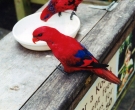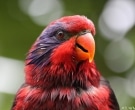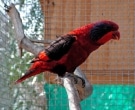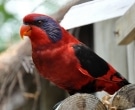30 cm.. height and an approximate weight of 120 gr.
The Black-winged Lory (Eos cyanogenia) has a plumage predominantly red.
Adults have a blue patch surrounding the eyes, cover the tops of the ear and reaches the back of the neck.
Feathers covering the shoulder blade (scapular), small feathers that cover the outside (coverts) and bend of wing are black. The primary and high school they have a black bordered.
The the thighs and flanks they are sprinkled with black. The bottom of the wings shows a wide band Red. The feathers of the tail are black contrasted with red feathers.
The bill is red-orange. The irises they are red, legs grey.
The youth they are more muted than adults. They have blue-black ends in feathers of the head, neck and underparts. The the wing covers are black, with a green light opaque. The bill is of color brown orange, irises brown.
The Black-winged Lory It can be confused with almost all parrots of the genus Eos, but is the only one of this category that has the covered wing Black.
- Sound of the Black-winged Lory.
The Black-winged Lory they are quite common and widespread in coastal areas, coconut plantations, the forested areas in the process of regeneration, in some large trees scattered in bushes Moors and local gardens.
In some small islands such as Supiori, they are also present in large numbers in the forests of the interior.
Residing in altitudes ranging from sea level to the 460 m.
They live in pairs or in small family groups. They are also often found in flocks of forty individuals or more.
Are noisy birds and easily observable. At the local level are very popular. In the Biak island, the natives capture them frequently as birds of company.
The Black-winged Lory they have a fly quick and direct. Often you can hear the hum of their wings when they fly over the villages. They are even more recognizable when they often fly at low altitude, well below the tops of the trees.
Little is known of their reproductive ecology, but it was observed the presence of a possible nesting site in a hole in a tall tree in the forest by a couple during the observations in 1982.
The incubation in harsh captivity around 26 days, and as in all loris, the nesting cycle is particularly long and hard between 75 and 89 days.
They have a regime that differs little from other parrots of the genus Eos. Feed in the trees in flower of nectar of Brugierto and pollen. The menu probably are complemented with fruit, berries of the mistletoe and sometimes insects.
Being endemic to the islands of the Cenderawasih Bay in the part Indonesia of New Guinea.
They live in most of the Islands (Numfor, Biak, Manim, Pulau Num) but are absent from Yapen, the main island, where are replaced by the Dusky Lory (Pseudeos fuscata).
– Current IUCN Red list category: Vulnerable
– The population trend: Decreasing
The population is estimated at 2,500 to 9,999 mature individuals.
Logging and subsistence agriculture have driven the loss of forests within their range and the hunting pressure remains a threat. As a result, the species is suspected to be declining at a moderate pace.
Relatively a number large of birds have been trapped for the national and international trade.
Since December of 1989, the import of the Black-winged Lory It is strictly prohibited in the European Community.
Conservation Actions Proposed:
– Conduct surveys on all the Geelvink Islands to clarify its distribution and current population status.
– The investigation of its ecology and movements to facilitate the planning of their conservation.
– Investigate the species trade and design and implement appropriate controls.
– Estimating the rate of loss of forests within its range.
– Check the register in Supiori and to establish a breeding programme in captivity to support future efforts of re-introduction and supplementation.
This species is observed commonly referred to as pet in Biak (island located in the Cenderawasih Bay, near the North coast of Papua).
Due to its status in danger of extinction, any specimen that can not be returned to their natural habitat (natural range) It should be placed preferably in a breeding program well managed to ensure the survival of the species.
- Black winged Lory, Biak Red Lory, Black-winged Lory (ingles).
- Lori à joues bleues (francés).
- Schwarzschulterlori (alemán).
- Lóris-asa-negra (portugués).
- Lori Alinegro, Lori de Alas Negras (español).
- Orden: Psittaciformes
- Familia: Psittaculidae
- Nombre científico: Eos cyanogenia
- Citation: Bonaparte, 1850
- Protónimo: Eos cyanogenia
————————————————————————————————-
Black-winged Lory (Eos cyanogenia)
Sources:
– Avibase, Oiseaux.NET, BirdLife.org
– Photos: galleryhip.com, Sheri Hanna
– Sounds: Hans Matheve (Xeno-canto)






